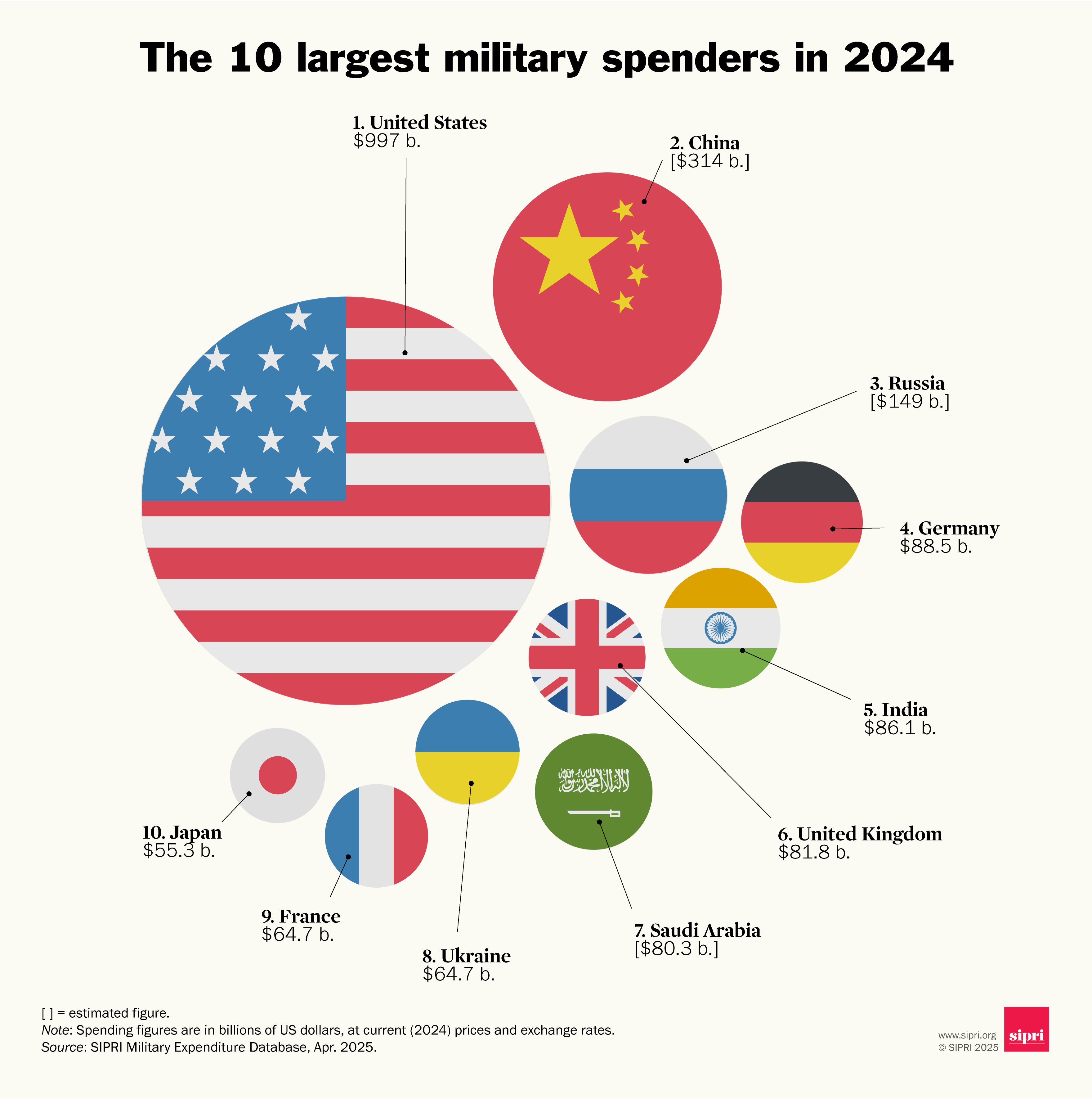Context:
According to the latest report by the Stockholm International Peace Research Institute (SIPRI), global military spending surged to a record $2,718 billion in 2024, marking a 9.4% increase in real terms—the steepest year-on-year growth since the end of the Cold War. The top five spenders—the United States, China, Russia, Germany, and India—accounted for 60% of total global expenditure, jointly spending $1,635 billion.
India’s Position in Global Military Expenditure
- India is the world's fifth-largest military spender after the United States ($997 billion), China ($314 billion), Russia ($149 billion), and Germany ($88 billion). India's defence spending was listed at $86 billion in 2024, placing it a fraction ahead of the United Kingdom ($82 billion) and Saudi Arabia ($80 billion). In sharp contrast, Pakistan is at number 29 with a defence budget of $10 billion, which is almost nine times more than that of its western neighbour.
- In spite of this significant outlay, India spends just 1.9% of its GDP on defence, which most experts contend is inadequate considering the twin-front threat it faces from two nuclear neighbours—Pakistan and China. Defence experts suggest at least 2.5% of GDP to create credible deterrence and stay strategically prepared.
Strategic Context and Border Tensions
India is in a difficult position. It has two active borders with nuclear powers:
- With Pakistan, the ceasefire along the Line of Control (LoC) has become weak, especially after recent terror attacks like the Pahalgam massacre.
- With China, over 100,000 troops are still deployed along the Line of Actual Control (LAC), even though there has been some disengagement in eastern Ladakh.
Structural Limitations in India’s Defence Spending
A major concern with India’s ₹6.8 lakh crore ($80 billion) defence budget for FY 2025–26 is its allocation structure—only 22% is designated for capital procurements, which fund new weapon systems and platforms. The bulk is spent on salaries, operational expenses, and pensions for over 3.4 million ex-servicemen and defence civilians, limiting military modernisation.
Additionally, India’s weak defence-industrial base keeps it the world’s second-largest arms importer, and the lack of coherent long-term strategic planning hampers alignment of military capabilities with its geopolitical goals.
This has led to operational shortages in critical areas such as:
- Fighter aircraft
- Submarines
- Helicopters
- Air defence systems
- Anti-tank guided missiles
- Night-fighting equipment
China and Pakistan current capabilities:
While India struggles with systemic inefficiencies, China is rapidly modernizing its military. In 2024, it increased its defence budget by 7% to $314 billion—its 30th consecutive annual rise. Analysts believe China’s actual military spending likely exceeds official figures.
Key highlights of China’s 2024 military modernization include:
- Deployment of new stealth combat aircraft
- Development of advanced UAVs and uncrewed underwater vehicles
- Rapid expansion of its nuclear arsenal
- Formation of aerospace and cyberspace forces
- Strengthened capabilities in counter-space and cyberwarfare
While Pakistan’s military budget remains modest in comparison, it continues to pose asymmetric and proxy threats, particularly in Kashmir and across the LoC, making it a persistent security challenge for India.
Conclusion:
India’s defence challenges are not merely budgetary but also structural and strategic. While it remains a top global spender, the return on investment is diluted by skewed expenditure priorities and institutional inefficiencies. In light of a hostile neighbourhood, nuclear brinkmanship, and rapid technological evolution in warfare, India must urgently:
- Enhance capital allocations
- Boost indigenous defence manufacturing
- Implement long-term capability-building roadmaps
- Increase defence-GDP ratio to at least 2.5%
Only through such comprehensive reforms can India hope to transform its numerical advantage into strategic effectiveness, ensuring readiness against an increasingly unpredictable and militarized global order.







